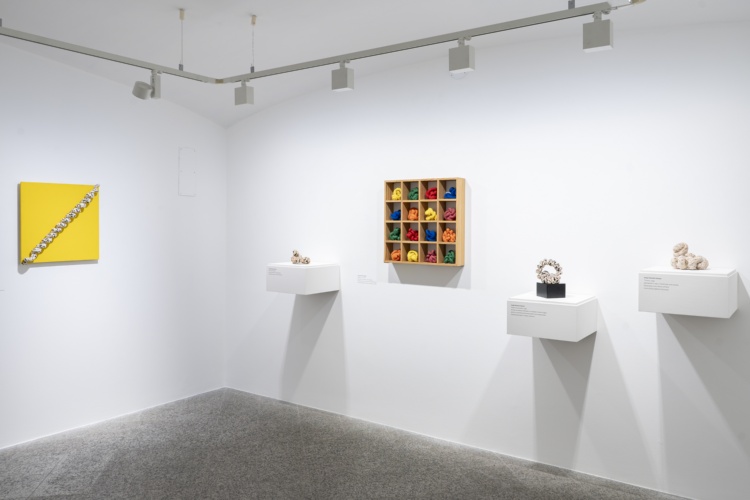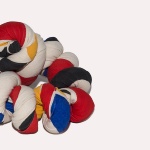
Main site sections
Maria Lai and Jorge Eielson
100thousand stars
14.07
-
01.10.2023
curated by Elisabetta Masala, based on an idea by Marina Affanni and Chiara Gatti
in collaboration with The Maria Lai Archives, the Centre for Jorge Eielson Studies, Florence, and the Jorge Eielson Saronno Archives
The MAN Museum in Nuoro is to present the first institutional exhibition exploring the profound intellectual and emotional bond between Maria Lai (1919–2013) and the Peruvian artist Jorge Eielson (1924–2006).
Against the backdrop of rural Sardinia, deep in the remote landscapes of the Ogliastra region, two extraordinary artists of the twentieth century wove their personal and expressive histories together. They shared their reflections on aesthetics and the world, created art together, and dedicated writing and images to one another. Jorge's poems offered Maria new fairy tales for her threads, while Lai's Sardinia – with its ancient past, its fairies and the Mediterranean – nourished both Jorge's verse and the knotted bits of cloth he had brought with him: with these, he stitched his South American heritage onto the primitive iconography of his adopted homeland.
Eielson had left Peru in 1948 and lived in Paris and Switzerland, before settling in Italy in 1951. In Bari Sardo, his life became entwined with that of another local author and artist, Michele Mulas, who bore witness to the emerging creative friendship. It would develop over the 1980s and '90s, establishing a path of shared thinking on recurring lyrical themes such as nature and the cosmos, writing and love.
As Elena Pontiggia notes: "There was also plenty of common ground in their work. Lai and Elson were both engaged with the prevailing trend in contemporary art to use the canvas as a material; indeed they were among its foremost exponents. It's a practice which extends from Burri's Sacks to Scarpitta's ‘bandages’; from Piero Manzoni's kaolin-soaked canvases to the shadowy effects of Castellani and Bonalumi; all the way to Dadamaino's ‘Volumes’ and the work of Simeti, Mario Surbone, and many others. Its origins therefore go back to Art Informel, primarily that of the 1950s, though they find new expression with the Azimut group towards the end of the decade. The two periods had antithetical ideals, however: for Burri and Scarpitta the canvas was essentially a material, while for Manzoni and co. it was an 'anti-material' – an aspect of the aspiration to silence that ran through their work, which sought to overcome physicality and the ‘rallying cry’ of the informal. Eielson also made use of the canvas, but with different intentions. The knot, or quipo, an ancient symbol used by the Incas, has a fundamental significance in his work, symbolising both a centre of cosmic energy and the primary, almost molecular nucleus within every being. Eielson had made use of textiles as early as his Assemblages, and they seemed to provoke some existential thinking: 'I felt this spontaneous need to incorporate garments that [...] had a very specific existential reality [into the work]. It includes whole sets of shirts, blue jeans, jackets and trousers, women's clothes, eveningwear, shoes, socks, ties, and accessories of all kinds. [...] I subjected these garments to all manner of treatments: they were ripped, burnt, cut up, twisted and finally, knotted,' the artist noted.”
Curated by MAN Curator Elisabetta Masala, the exhibition offers a survey of roughly 60 works by Maria Lai and Jorge Eielson. Some of these works have never been seen before and are displayed here for the first time, having been discovered in private collections, as well as the artists' respective personal archives. The exhibition unfolds through their two voices, which sees paintings, canvases, sculptures and technical experiments by Lai and Eielson organised into different sections: landscape, poetry, stars, geographies. The aim is to restore the shared feeling and little 'knots' that underpin the anthropological motives behind both artists' work, from the island's past to that of the native Indigenous Peoples of Peru.
The exhibition will feature a screening of Patricia Pereyra's film, Eielson Des-Nudo
Bilingual catalogue published by Nomos Edizioni
Critical essays by Martha Canfield and Marco Benacci, Elisabetta Masala, Elena Pontiggia and Carlos Castro Sajami, Luis Rebaza-Soraluz, Mariana Rodríguez Barreno
Press enquiries:
STUDIO ESSECI - Sergio Campagnolo
Via San Mattia 16, 35121 Padova
Tel. +39.049.663499
Contact: Simone Raddi, simone@studioesseci.net
www.studioesseci.net




